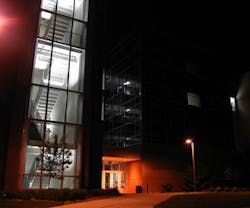Designing with an Eye on Security
For me, it started as an e-mail from my old college roommate with a link and the simple phrase: “Something bad is happening at Tech.”
Although I was thousands of miles away, working in the London office of Steffian Bradley Architects, when I clicked on the link and saw the events playing out at Virginia Tech, I was instantly transported back to Blacksburg, VA. The images on the monitor were familiar and surreal; from that moment forward, the peaceful college campus where I had spent nearly a decade of my life would be changed forever.
At Virginia Tech, many of my second- and third-year classes were held in Norris Hall. The beautiful, gothic building is typical of many classroom buildings constructed in the mid-20th century, with long, double-loaded corridors to maximize usable space, and stairs and exits located to allow for an orderly evacuation. Most classrooms hold about 50 people and have a single door. It’s likely that the people who designed this building were more concerned about nuclear fallout than a student rampaging through the corridors with an automatic weapon, but that’s exactly what happened on April 16, 2007.
The administration at Virginia Tech was criticized and praised in equal measure for their handling of the situation, but they’ve moved forward to become a leader in implementing campus alert systems, utilizing the Internet, e-mail, text messaging, telephones, electronic message boards, and campus sirens and loudspeakers, creating a multiple-redundant system that has been replicated on campuses across the country and has, in fact, become the norm for colleges and universities across the country.
As architects, we’re left to work out what we can do to help stem the tide of campus violence that we experienced firsthand over the past year with violence at a number of campuses, including the University of Connecticut, Florida International University, and Yale. As a profession, we generally agree that the “open” campus model is something we don’t want to lose. (Would Yale’s Old Campus or Harvard Yard retain their character if they were dotted with metal-detector check points?) Obviously, the design solution has to be more subtle and work in tandem with technology and communication to create a campus that’s welcoming and as safe as possible.
For buildings, entrances and exits are a good place to start. I remember the traditional “crash bars” at all exits at Virginia Tech, which could easily be chained and padlocked. Contemporary push-pad exit devices allow the same ease of exit in case of an emergency, but can only be locked by an authorized person using a key. In the classrooms themselves, a helpful security option is to provide an emergency push-button intercom connected directly to campus or local security akin to what’s used in banks or in nurse-call systems. By using Internet connections already in the classroom, it would be possible for professors or students to quickly call for help in case of classroom violence or a common medical emergency.
In addition to the buildings themselves, there’s also the concern about the campus at large, which is typically dealt with through the campus master plan. While building shape and placement is usually considered for program, adjacencies, and overall aesthetics, it’s also important to consider sightlines and views between buildings, the location of lights and emergency call-boxes, as well as multiple paths for evacuating a space. These concepts have always been a concern for individual crimes, such as muggings and rape, but perhaps it’s time to consider that large groups of people may need to exit a section of campus quickly to avoid an individual intent on doing harm to as many people as possible. Steffian Bradley Architects recently completed a project at Lasell College in Massachusetts that constructed much-needed parking underground with a green roof on top, creating a new residential quad for the school. By providing a wide-open, grassy quad in place of a congested surface parking lot, we were able to provide a space that was not only more student-friendly and aesthetically pleasing, but also more sustainable and much safer.
We can’t solve the issues of campus security with architecture alone – it needs to be a combination of design, communication, and technology resulting from a focused discussion between the university and the designers. If thinking more about safety in our designs helps to save just one student or faculty/staff member, then it will be time well spent.
Chris Waltz is a senior associate at Steffian Bradley Architects’ Enfield, CT, office.
